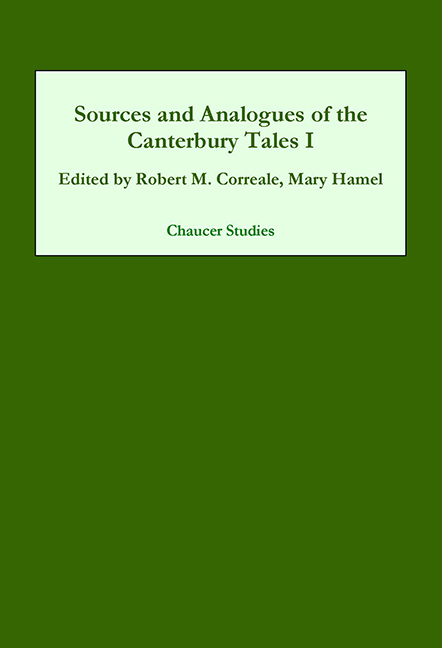Book contents
- Frontmatter
- Contents
- preface
- Acknowledgements
- The Frame
- The Reeve's Tale
- The Cook's Tale
- The Friar's Tale
- The Clerk's Tale
- The Squire's Tale
- The Franklin's Tale
- The Pardoner's Prologue and Tale
- The Tale of Melibee
- The Monk's Tale
- The Nun's Priest's Tale
- The Second Nun's Prologue and Tale
- The Parson's Tale
- Contributors and editors
- General Index
- Index of Manuscripts
The Pardoner's Prologue and Tale
Published online by Cambridge University Press: 25 October 2017
- Frontmatter
- Contents
- preface
- Acknowledgements
- The Frame
- The Reeve's Tale
- The Cook's Tale
- The Friar's Tale
- The Clerk's Tale
- The Squire's Tale
- The Franklin's Tale
- The Pardoner's Prologue and Tale
- The Tale of Melibee
- The Monk's Tale
- The Nun's Priest's Tale
- The Second Nun's Prologue and Tale
- The Parson's Tale
- Contributors and editors
- General Index
- Index of Manuscripts
Summary
As original a character as the Pardoner is, his extraordinary self-presentation in his Prologue is based to a certain degree on the confession of Faux Semblant in the Roman de la Rose, a source that also influenced the portrait of the Friar in the General Prologue. The influence is shown here not only by the defiant shamelessness of the two confessions, with their shared themes of hypocrisy and venality, but by a few specific, significant shared ideas and some verbal parallels.
Chaucer's procedure in the Pardoner's Prologue was nevertheless eclectic enough to intermingle these echoes with other materials, not least of which is observed actual behavior, by the evidence of sermons and Langland. The parallels to lines 377–88, the Pardoner's “gaude” whereby those guilty of “synne horrible” were forbidden to offer to his relics, were therefore judged too general to constitute real analogues and so are not included here: in the words of Albert C. Friend, “This hoax was a tale widely current in the fourteenth century.” For this reason, attention is concentrated here on the Roman de la Rose; but a somewhat larger selection from the confession of Faux Semblant is included to demonstrate not only verbal parallels but also parallelism of idea that implies a more general influence.
The choice of text was somewhat problematic; for the most appropriate text to demonstrate Chaucer's source may well be that of the C-fragment of the Middle English Romaunt of the Rose, which exemplifies the kind of text Chaucer most likely had access to, whoever was responsible for the translation. For this reason, equivalent line numbers from Fragment C are footnoted below. For the French text, though more recent editions are available, that of Langlois is chosen here as “the one most fully annotated and that provides the greatest number of variants.” In particular, two interpolated passages not found in the best manuscripts of the Roman de la Rose have some importance for the Pardoner's Prologue, and these are printed here from Langlois's notes.
- Type
- Chapter
- Information
- Sources and Analogues of the Canterbury Tales: vol. I , pp. 267 - 320Publisher: Boydell & BrewerPrint publication year: 2002



